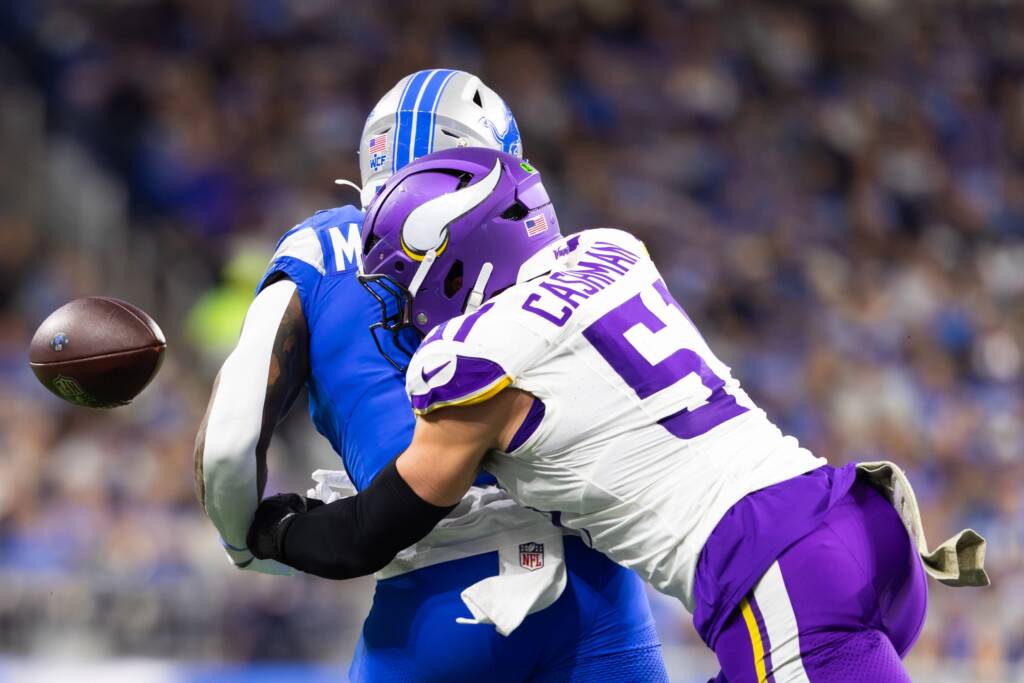Blake Cashman knows the Minnesota Vikings aren’t turning the ball over like they previously did under Brian Flores. He also believes the 3-0 turnover margin was the difference in Minnesota’s 27-19 loss to the Baltimore Ravens on Sunday.
“The narrative of the game was we had turnovers, and, defensively, we didn’t take the ball away,” he said. “This defense is made to take the ball away, and we weren’t disruptive.”
The Vikings forced 33 turnovers last year, 12 more than their opponents, and at least one in each game aside from their playoff loss to the Los Angeles Rams. However, they have only nine through nine games this year, including five against the Cincinnati Bengals. Last year, they had 17 after Week 9.
So, what gives?
“Sometimes, it’s just the flow of the game,” explained Cashman. “I don’t think Baltimore was really taking much risk.”
The Vikings were 7-2 through nine games last year. They won or tied the turnover battle in every game but their loss to the Los Angeles Rams. They tied the turnover margin 1-1 in their home loss to the Detroit Lions.
Minnesota’s season had started unspooling by Week 9 last year. Detroit created a blueprint that other teams could use to beat them, and the Rams had used in LA. The Vikings’ season ended in the same sequence. The Lions beat them at Ford Field, then the Rams eliminated them in Arizona.
However, Minnesota’s schedule was soft in the middle, and its opponents couldn’t take advantage of Detroit’s blueprint.
Minnesota’s defense attacked a 39-year-old Joe Flacco relentlessly when he played for the Indianapolis Colts last year. Sam Darnold melted down against the Jacksonville Jaguars, but the Vikings still won that game. They didn’t play much better in Nashville, but still beat the Tennessee Titans.
Still, nobody, not even the Green Bay Packers and Seattle Seahawks, took advantage of Detroit’s blueprint. It wasn’t until the Vikings played the Lions and Rams again that an opponent fully exploited their interior offensive line’s weaknesses and attacked their defense with dig routes (Detroit) or deep outs (LA).
The Vikings often played with a lead last year because they faced more challenging opponents earlier in the schedule before heading to Europe, then took advantage of a soft middle of their schedule. Ultimately, the defense was better able to turn the ball over, but much of that was related to game flow.
However, they have the opposite schedule this year. The easy part was before they headed to London. But McCarthy underperformed in seven of the first eight quarters, and Carson Wentz played like a typical backup. Now, they’re in the throes of their schedule and don’t have much margin for error.
Minnesota started chasing the Ravens game after its ill-fated third-and-one decision immediately after halftime. Baltimore took the lead and never relinquished it because John Harbaugh leaned on Lamar Jackson and Derrick Henry’s legs to control the game.
“They’re running the football,” explained Cashman, adding that Jackson had more success with quick passes and didn’t drop back to pass often. “It’s hard to take the ball off the team when they’re not absorbing risk.”
Minnesota’s defense will be better able to create turnovers if the Vikings play with a lead. In the offseason, they built a defense to play while ahead. The Vikings have given up 125.6 yards per game on the ground, 12th-worst in the NFL. However, Minnesota’s opponents have only averaged 191.7 passing yards, ninth-best in the league.
The Vikings gave up a key component of their running defense when they traded Harrison Phillips in the offseason. However, Javon Hargrave and Jonathan Allen should create interior pressure, which forces quarterbacks to scramble and throw off schedule. That pressure should alleviate their lack of secondary depth and create turnovers as teams press to score.
Andrew Van Ginkel says the Vikings will continue to work on the fundamentals in practice.
“We need to create turnovers. That’s what we pride ourselves on,” Van Ginkel said. “It’s something that we got to continue to focus on and put an emphasis on. We’re going for it, [and] the opportunities will come. They’ll come in a bunch.”
However, the Vikings likely have good fundamentals when it comes to creating turnovers. It’s something that Brian Flores and special teams coordinator Matt Daniels, who is also Minnesota’s turnover guru, emphasize. Minnesota needs to get off to faster starts because no team is going to take a risk when they’re sitting on a lead.

